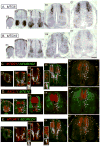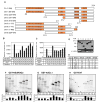Interaction of MTG family proteins with NEUROG2 and ASCL1 in the developing nervous system
- PMID: 20214951
- PMCID: PMC2862279
- DOI: 10.1016/j.neulet.2010.03.004
Interaction of MTG family proteins with NEUROG2 and ASCL1 in the developing nervous system
Abstract
During neural development, members of MTG family of transcriptional repressors are induced by proneural basic helix-loop-helix (bHLH) transcription factors and in turn inhibit the activity of the bHLH proteins, forming a negative feedback loop that regulates the normal progression of neurogenesis. Three MTG genes, MTG8, MTG16 and MTGR1, are expressed in distinct patterns in the developing nervous system. Various bHLH proteins are also expressed in distinct patterns. We asked whether there is a functional relationship between specific MTG and bHLH proteins in developing chick spinal cord. First, we examined if each MTG gene is induced by specific bHLH proteins. Although expression of NEUROG2, ASCL1 and MTG genes overlapped, the boundaries of gene expression did not match. Ectopic expression analysis showed that MTGR1 and NEUROD4, which show similar expression patterns, are regulated differently by NEUROG2 and ASCL1. Thus, our results show that expression of MTG genes is not regulated by a single upstream bHLH protein, but represents an integration of the activity of multiple regulators. Next, we asked if each MTG protein inhibits specific bHLH proteins. Transcription assay showed that NEUROG2 and ASCL1 are inhibited by MTGR1 and MTG16, and less efficiently by MTG8. Deletion mapping of MTGR1 showed that MTGR1 binds NEUROG2 and ASCL1 using multiple interaction surfaces, and all conserved domains are required for its repressor activity. These results support the model that MTG proteins form a higher-order repressor complex and modulate transcriptional activity of bHLH proteins during neurogenesis.
Copyright 2010 Elsevier Ireland Ltd. All rights reserved.
Figures




Similar articles
-
Feedback regulation of NEUROG2 activity by MTGR1 is required for progression of neurogenesis.Mol Cell Neurosci. 2009 Dec;42(4):267-77. doi: 10.1016/j.mcn.2009.07.011. Epub 2009 Jul 28. Mol Cell Neurosci. 2009. PMID: 19646530 Free PMC article.
-
Regional expression of MTG genes in the developing mouse central nervous system.Dev Dyn. 2009 Aug;238(8):2095-102. doi: 10.1002/dvdy.22021. Dev Dyn. 2009. PMID: 19618476 Free PMC article.
-
Transcriptional regulatory events initiated by Ascl1 and Neurog2 during neuronal differentiation of P19 embryonic carcinoma cells.J Mol Neurosci. 2015 Mar;55(3):684-705. doi: 10.1007/s12031-014-0408-2. Epub 2014 Sep 6. J Mol Neurosci. 2015. PMID: 25189318
-
Proneural genes in neocortical development.Neuroscience. 2013 Dec 3;253:256-73. doi: 10.1016/j.neuroscience.2013.08.029. Epub 2013 Aug 30. Neuroscience. 2013. PMID: 23999125 Review.
-
Instructing neuronal identity during CNS development and astroglial-lineage reprogramming: Roles of NEUROG2 and ASCL1.Brain Res. 2019 Feb 15;1705:66-74. doi: 10.1016/j.brainres.2018.02.045. Epub 2018 Mar 3. Brain Res. 2019. PMID: 29510143 Review.
Cited by
-
Genome-wide association study identifies CBFA2T3 affecting the rate of CSF Aβ42 decline in non-demented elders.Aging (Albany NY). 2019 Aug 1;11(15):5433-5444. doi: 10.18632/aging.102125. Epub 2019 Aug 1. Aging (Albany NY). 2019. PMID: 31370031 Free PMC article.
-
Endothelial angiogenesis is directed by RUNX1T1-regulated VEGFA, BMP4 and TGF-β2 expression.PLoS One. 2017 Jun 22;12(6):e0179758. doi: 10.1371/journal.pone.0179758. eCollection 2017. PLoS One. 2017. PMID: 28640846 Free PMC article.
-
Transient expression of Ngn3 in Xenopus endoderm promotes early and ectopic development of pancreatic beta and delta cells.Genesis. 2012 Mar;50(3):271-85. doi: 10.1002/dvg.20828. Epub 2012 Jan 30. Genesis. 2012. PMID: 22121111 Free PMC article.
-
Ascl1 Coordinately Regulates Gene Expression and the Chromatin Landscape during Neurogenesis.Cell Rep. 2015 Mar 10;10(9):1544-1556. doi: 10.1016/j.celrep.2015.02.025. Epub 2015 Mar 5. Cell Rep. 2015. PMID: 25753420 Free PMC article.
-
Runx1t1 promotes the neuronal differentiation in rat hippocampus.Stem Cell Res Ther. 2020 Apr 22;11(1):160. doi: 10.1186/s13287-020-01667-x. Stem Cell Res Ther. 2020. PMID: 32321587 Free PMC article.
References
-
- Amann JM, Chyla BJI, Ellis TC, Martinez A, Moore AC, Franklin JL, McGhee L, Meyers S, Ohm JE, Luce KS, Ouelette AJ, Washington MK, Thompson MA, King D, Gautam S, Coffey RJ, Whitehead RH, Hiebert SW. Mtgr1 is a transcriptional corepressor that is required for maintenance of the secretory cell lineage in the small intestine. Mol Cell Biol. 2005;25:9576–9585. - PMC - PubMed
-
- Cao Y, Zhao H, Grunz H. XETOR regulates the size of the proneural domain during primary neurogenesis in Xenopus laevis. Mech Develop. 2002;119:35–44. - PubMed
Publication types
MeSH terms
Substances
Grants and funding
LinkOut - more resources
Full Text Sources
Molecular Biology Databases

